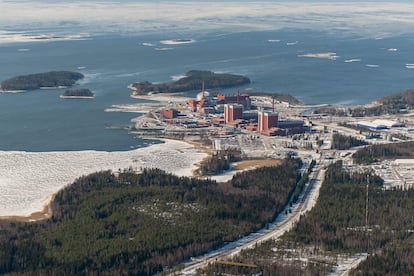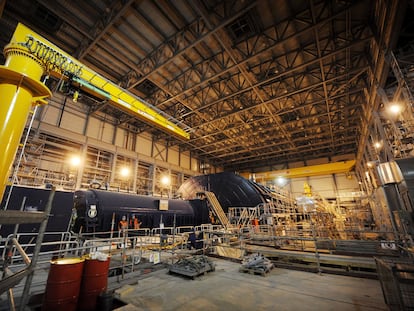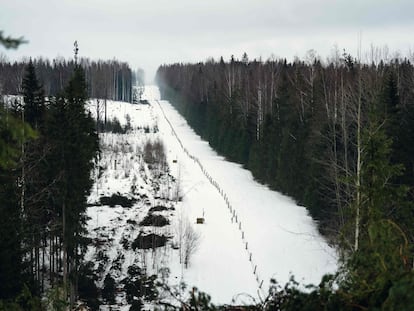Germany and Finland: Two sides of the nuclear power coin in Europe
The shutdown of the remaining German reactors coincides with the startup of a new reactor on the Finnish coast

As chance would have it, the shutdown of the Germany’s remaining nuclear reactors coincided exactly with the opening of a new one in Finland, the second in over 15 years in the European Union (EU). Both countries are highly vulnerable to the vagaries of Russian energy sources, but represent two opposing European visions of the always controversial nuclear energy.
The timing could not have been more incongruous. Almost 12 years after Angela Merkel’s administration decided to abandon nuclear power following the Fukushima (Japan) disaster, three plants were disconnected from the grid and mothballed: Isar 2 (Bavaria); Neckarwestheim 2 (Baden-Württemberg); and Emsland (Lower Saxony). A few hours later, in the early hours of the morning, the largest reactor in Europe was inaugurated 1,000 miles to the north. After almost 15 years of construction and many cost overruns, the Olkiluoto Nuclear Power Plant started producing 1.6 gigawatts (GW) of electricity, about one seventh of Finland’s total electricity demand.
The start-up of the Finnish reactor was a rocky road: it was first scheduled to be completed in 2009 and cost $12 billion, three times more than the original estimate. With Finnish conservatives holding a firm grip on power, more nuclear power projects are expected. Petteri Orpo, the front-runner in the prime minister race, often says in campaign speeches that nuclear power should be “the cornerstone of Finnish energy policy.”
The brutal energy shock aggravated by the Russian invasion of Ukraine has recently rekindled the debate about the role of nuclear power in Europe. Germany delayed the closure of its reactors by four months amid the energy crisis, and several political parties (including Merkel’s center-right CDU party) have reversed their original positions. The International Energy Agency (the Organization for Economic Cooperation and Development’s energy arm) has emerged as a leading advocate for nuclear reactors in a context increasingly dominated by renewable energy. A report by the International Energy Agency last summer noted the growing momentum for nuclear energy in many countries given rising fuel prices and growing concerns about stable energy supplies.
“If Germany is closing reactors, it’s because of ideological factors, not economic or climate change issues. There is more fear of a nuclear accident and waste than of global warming,” said Alejandro Zurita, former head of international nuclear research cooperation at Euratom. “It seems irrational to close plants that have operated safely for decades and help curb CO₂ emissions.”
Although wind and photovoltaic energy are gaining traction in Germany, Europe’s biggest economy and most populous country, fossil fuels will have to fill some of the gap left by the nuclear plant shutdowns (6% of Germany’s electricity in 2022). Highly polluting coal plants still produce a third of the country’s electricity but will have to close by 2038.
In contrast, Finland justified the Olkiluoto plant decision in the early 2000s with two arguments that remain valid today — energy independence and compliance with emission limits. “Fossil fuel plants have to be replaced by accelerating renewable energy development without giving up nuclear power generation,” said Zurita.
Consultant and environmentalist Mycle Schneider, author of one of the most comprehensive annual report on the global state of nuclear power, doesn’t see it that way. “What we see in Germany is a measured but speedier version of a European trend: the decline of the nuclear industry,” he told EL PAÍS in an e-mail. “It’s a progressive closure — the renewal rate is insufficient for nuclear energy to survive.”
Schneider, a German expert based in Paris, says in the last 30 years EU countries have connected 16 new reactors, closed 47 and started construction on only two: Flamanville 3 (in France) and Olkiluoto 3. “Since the construction of these facilities began, the cost of solar [photovoltaic] energy has plunged by 90% and wind power by 70%. It’s simply impossible for a nuclear plant to compete with those low costs,” he said. Over the same period, the EU has added 157 GW of solar energy capacity, wind has added 175 GW, and nuclear has accounted for a 24 GW loss in capacity.
Paris and Berlin dominate the debate
Apart from the diverging paths of Berlin and Helsinki, the nuclear energy debate is still dominated by the two major continental powers: Germany, which has the unwavering support of Spain and Austria, and France, supported by several Eastern European countries.
Broad swaths of German society vehemently oppose nuclear energy, unlike French society and its government. France depends highly on nuclear energy, even during 2022 when a plague of technical issues caused shutdowns of many power plants. 60% of France’s electricity is nuclear, perhaps because prior to its 2016 corporate restructuring, Areva — a global power in nuclear plant construction — was majority-owned by the French state. Areva was the lead engineering firm for Olkiluoto 3. However, the future of nuclear energy will not be driven by France, Germany or the EU, says Zurita, but by “China, India, South Korea and the other emerging countries” that are growing so rapidly.
Sign up for our weekly newsletter to get more English-language news coverage from EL PAÍS USA Edition
Tu suscripción se está usando en otro dispositivo
¿Quieres añadir otro usuario a tu suscripción?
Si continúas leyendo en este dispositivo, no se podrá leer en el otro.
FlechaTu suscripción se está usando en otro dispositivo y solo puedes acceder a EL PAÍS desde un dispositivo a la vez.
Si quieres compartir tu cuenta, cambia tu suscripción a la modalidad Premium, así podrás añadir otro usuario. Cada uno accederá con su propia cuenta de email, lo que os permitirá personalizar vuestra experiencia en EL PAÍS.
¿Tienes una suscripción de empresa? Accede aquí para contratar más cuentas.
En el caso de no saber quién está usando tu cuenta, te recomendamos cambiar tu contraseña aquí.
Si decides continuar compartiendo tu cuenta, este mensaje se mostrará en tu dispositivo y en el de la otra persona que está usando tu cuenta de forma indefinida, afectando a tu experiencia de lectura. Puedes consultar aquí los términos y condiciones de la suscripción digital.
More information
Últimas noticias
Rowan Atkinson tops Netflix at 70: ‘He’s as funny as ever’
Israeli recognition of Somaliland stirs up the Gulf
Tiger Woods turns 50: Will he continue playing on the PGA Tour or take a back seat?
The surreal journey of James Nnaji, the Barcelona youth player selected in the NBA Draft who ended up in the NCAA
Most viewed
- Oona Chaplin: ‘I told James Cameron that I was living in a treehouse and starting a permaculture project with a friend’
- Reinhard Genzel, Nobel laureate in physics: ‘One-minute videos will never give you the truth’
- Sinaloa Cartel war is taking its toll on Los Chapitos
- Why the price of coffee has skyrocketed: from Brazilian plantations to specialty coffee houses
- Chevy Chase, the beloved comedian who was a monster off camera: ‘Not everyone hated him, just the people who’ve worked with him’











































